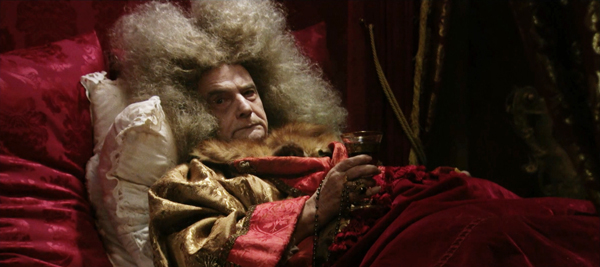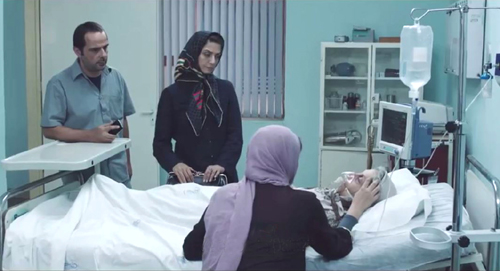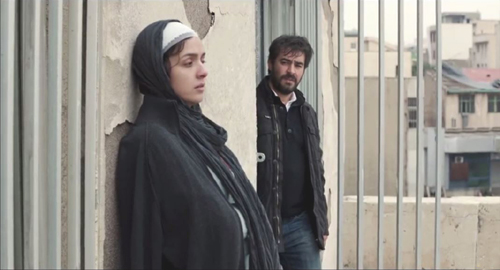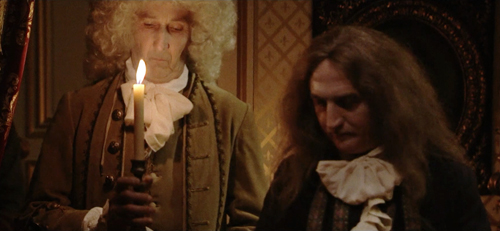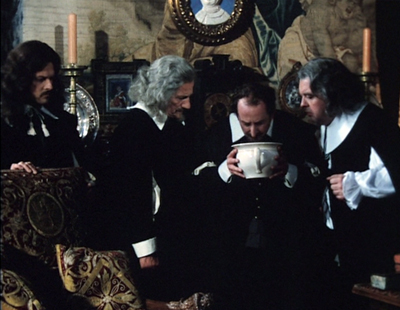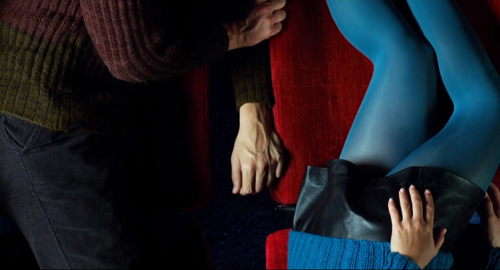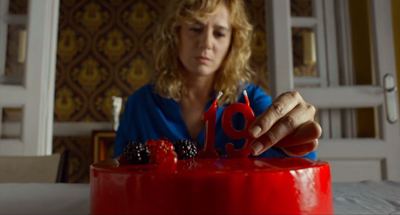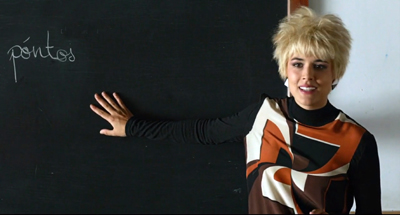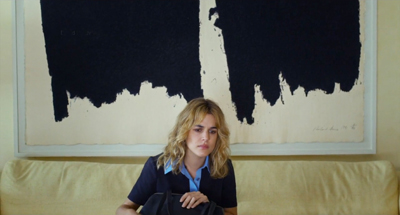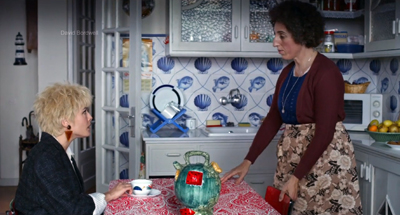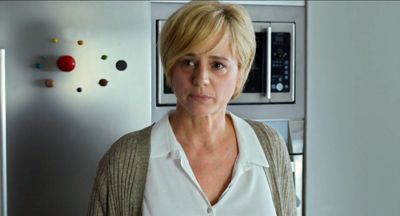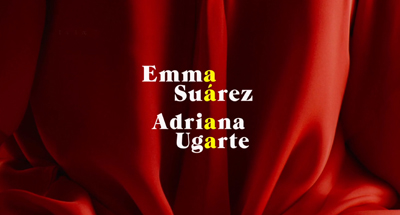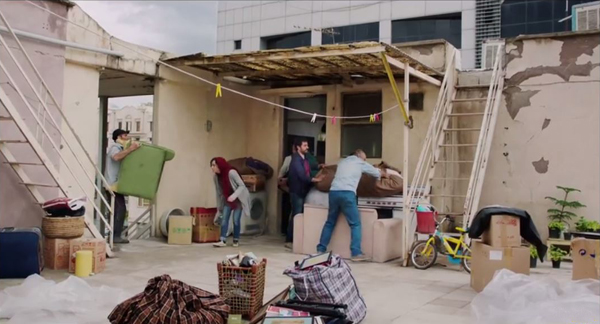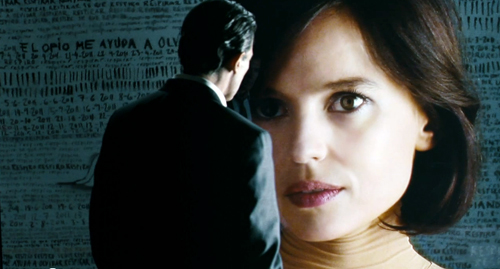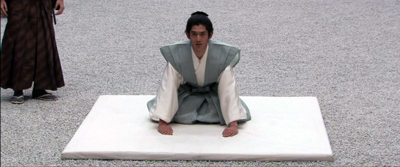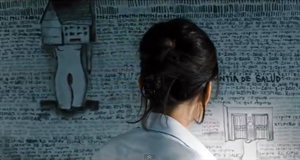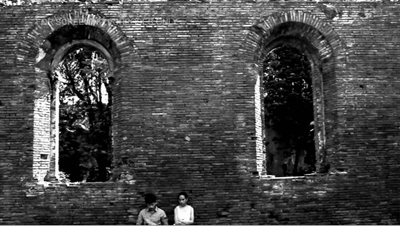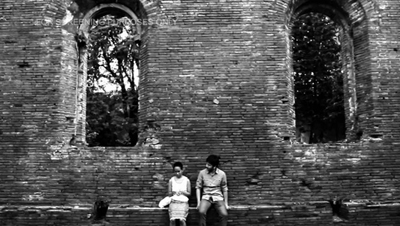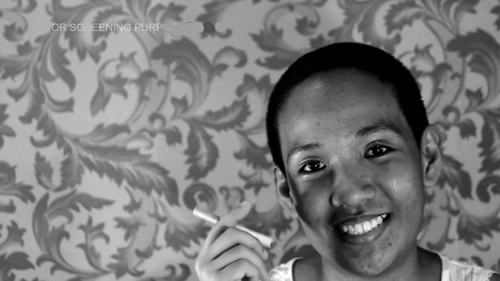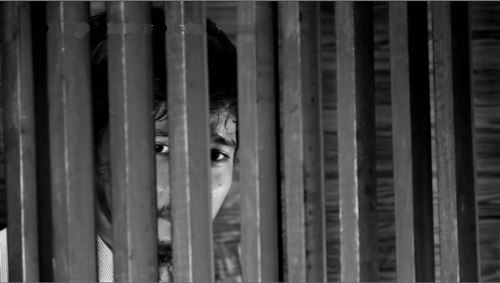Archive for the 'Directors: Almodovar' Category
More from VIFF 2016
The Death of Louis XIV (Albert Serra, 2016).
The Vancouver International Film Festival ended yesterday, but the films and the pleasures they yielded linger on. Our first two entries are by Kristin, the last two by David.
Smog over Tehran
Iranian film and television director Behnam Behzadi is not well-known outside his native country. Inversion, which was shown in the Un Certain Regard section of Cannes this year, suggests that he deserves to have more international exposure for his work.
The title refers to the meteorological phenomenon that can cause dense pollution to form at ground level. The film opens with shots of Tehran streets seen dimly through a thick haze. The pollution has a causal role to play, since the heroine’s elderly mother ends up in a hospital as a result of breathing problems. More metaphorically, however, the title refers to a sudden reversal in Niloofar’s situation.
Initially she seems to be in a relatively strong position for a Iranian woman. Still unmarried in her 30s, she runs a small, prosperous garments factory and begins to date an amiable man whom she clearly likes. Her mother’s sudden health crisis, however, leads a doctor to insist that she be moved to the healthier northern part of the country, where Niloofar’s sister and brother-in-law happen to own a small villa. Niloofar, with no spouse or children, is pushed by the couple and her brother into agreeing to go along and take care of her mother. She hopes to keep the factory going, but the brother selfishly rents out the premises to pay off his own debts. Niloofar resists going with her mother, but as her siblings ignore her wishes and she discovers that the man she may be considering marrying has kept an unpleasant secret from her, she realizes how little power she has over her own life.
As in Farhadi’s films, a seemingly ordinary situation suddenly deteriorates from a simple cause. But Farhadi tends to gain complexity by avoiding making his characters into villains. In his films, as in Renoir’s, “everyone has his reasons.” In Inversion, however, the brother is straightforwardly in the wrong, refusing to consider Niloofar’s desires and even threatening her with violence during one argument. Overall the film is entertaining, with Niloofar an engaging figure who gives an insight into the situation of women in contemporary Iran.
Mistakes were made
Asghar Farhadi is best known for A Separation (2011), the first Iranian film to win an Oscar for best foreign-language film. His earlier masterpieces, About Elly (2009) and my own favorite, Fireworks Wednesday (2006), are slowly coming to be known in the West, largely via home video. After the slightly disappointing The Past (2013), Farhadi is back on track with The Salesman.
The film opens with a tense, dramatic scene in which a Tehran apartment building threatens to collapse and its inhabitants frantically struggle to evacuate. The result is that the central characters, Emad and his wife Rana, must quickly find a temporary apartment (see bottom) while they also prepare to star in a production of Arthur Miller’s Death of a Salesman.
They seem to be coping until Rana mistakenly opens the door of their new apartment, assuming that her husband has come home. The shot holds on the door, standing ajar, as Rana moves off to take a shower and the scene ends. Later we learn that an unknown assailant has entered the apartment. Whether he raped Rana or simply startled her so that she fell and cut herself on broken glass is never revealed, but she is traumatized and unable to proceed, either with her everyday life or her role as Linda Loman in the play. Emad tries to be supportive, but he becomes obsessed with tracking down the intruder.
The mystery gradually unravels as the shady background of the apartment’s former tenant emerges, and revelation of the identity of the intruder undermines the question of revenge. As in Farhadi’s other films, characters’ mistakes, honest or otherwise, compound each other. Ultimately, absolute blame is hard to assign.
The Salesman won two prizes at Cannes: best screenplay for Farhadi and best actor for Shahab Hosseini as Emad. Amazon Studios and Cohen Media will release it in the US on 9 December.
The King is (nearly) dead
Early on in Roberto Rossellini’s Taking of Power by Louis XIV (1966), we find Cardinal Mazarin on his deathbed. Mazarin’s doctors decide to bleed him; a priest advises him on the disposal of his wealth; finance minister Colbert briefs him on intrigues at the king’s court. The shots are lengthy, following the men around the chamber.
This remarkably deliberate sequence was considered quite striking at the time. In a story centered on Louis XIV, Rossellini devotes thirteen minutes to Mazarin. His impending death creates exposition about the ensuing power struggles and initiates a somber pace rather different from that of the standard historical film. The scene also reminds us that historical events have a tangibly material side, as when doctors confer gravely over the stools in His Eminence’s chamber pot.
Rossellini, who’s interested in the tactics by which Louis tames the nobility, doesn’t show us the King’s final hours. That morbid task is taken up by Albert Serra’s The Death of Louis XIV. Unlike Rossellini’s film, which is filmed in radiant high-key and shows sumptuous detail of fabrics and flooring, Serra’s treatment relies on chiaroscuro, with shadow areas broken by trembling candlelight. And while Rossellini’s PanCinor lens swivels and zooms around these apartments, Serra cuts among close views of faces, hands, and a steadily blackening gangrenous royal foot.
In the process Serra expands the physicality of the Mazarin sequence to the length of an entire film. Louis seems to linger for days, but we’re given no distinct sense of how much time passes; in only two shots do we glimpse the outdoors, in bleary light that might be dawn, drab afternoon, or dusk. The time is filled out by court rituals, such as the King’s doffing his hat to his entourage, and by the steady decline of his powers. He can’t swallow food and can barely take water or wine. Through it all, Louis feebly issues his final orders about matters of state and the disposition of his body. A long scene of the last rites is punctuated by a barely discernible fart. This is a movie centrally about a degenerating body.
Even more than Rossellini did, Serra probes the shaky state of medical science of the time. (Louis died in 1715, just as the Enlightenment was beginning.) When Louis’s leg contracts gangrene, the learned doctors debate whether to amputate it. A quack shows up with an elixir made of bull sperm and other recherché ingredients. At the end, the principal physician takes the blame for the king’s death and makes a remarkable apology directly to the camera. Before that, though, Serra has given us a three-minute shot of His Highness reproachfully staring at us (up top) while we hear a Kyrie Eleison somewhere offscreen. Another echo of film history: Louis is played by Jean-Pierre Léaud, who looked out apprehensively at us many years ago, in the seashore ending of The 400 Blows. It’s glib to say that cinema films death at work, but here the cliché gains some meaning.
Master of the weepie
Is any filmmaker more unfairly taken for granted than Pedro Almodóvar? For over thirty years, he has created sparkling, handsome entertainments that combine cinematic intelligence with outrageous eroticism and insidious emotional punch. His films revel in plot complications and edgy humor. Along the way he effortlessly deploys the techniques that make modern cinema modern, from flashbacks and voice-overs to subjective sequences and abrupt replays that fill in gaps.
He makes it all look easy, and gorgeous. After the drab grays and browns of Hollywood fare, what a pleasure to see a film packed with saturated primaries and bold designs. He proves that you can go as dark as you like in plotting and still make things look delightful.
His characters are clothes horses, I grant you, but not the least of his debts to Old Hollywood is the belief that we want to see presentable people in pretty costumes and settings. The world is ugly enough, he seems to say; why add to it? Seeing The Girl on the Train reminded me how glum American movies are determined to look. An Almodóvar apple looks good enough to eat, and a housekeeper’s roseate apron seems the height of chic. In this world, even refrigerator magnets evoke a Calder mobile.
These elegantly voluptuous tales make unabashed appeal to Hollywood genres: the screwball comedy (Women on the Verge of a Nervous Breakdown, I’m So Excited), the illicit romance (Law of Desire, The Flower of My Secret), the twisty thriller (Live Flesh, The Skin I Live In), even the ghost story (Volver), and above all the melodrama—medical (Talk to Her) and maternal (High Heels, All about My Mother). He rolls Lubitsch, Sirk, and Siodmak into a nifty package, tied up with a ribbon bow of pansexuality.
 Julieta (from which all my images come) revisits the maternal melodrama, specifically the mother-daughter nexus. Our heroine, beginning as a spiky-haired classics teacher, seems to have an idyllic life married to a fisherman, but soon infidelity, misunderstandings, and a tempestuous storm shatter it. All the paraphernalia of melodrama—raging seas, unhappy coincidences, ingratitude, and dark secrets—threaten Julieta’s efforts to save her marriage and protect her daughter. Told in flashbacks, chiefly through a letter she writes her daughter Antia, the two major phases of Julieta’s life get intercut in surprising and gratifying ways. With his usual cleverness, Almódovar has Julieta played by two female performers, with a surprise match-on-action linking them in one scene. A beautiful purple towel helps, as the poster sneakily suggests.
Julieta (from which all my images come) revisits the maternal melodrama, specifically the mother-daughter nexus. Our heroine, beginning as a spiky-haired classics teacher, seems to have an idyllic life married to a fisherman, but soon infidelity, misunderstandings, and a tempestuous storm shatter it. All the paraphernalia of melodrama—raging seas, unhappy coincidences, ingratitude, and dark secrets—threaten Julieta’s efforts to save her marriage and protect her daughter. Told in flashbacks, chiefly through a letter she writes her daughter Antia, the two major phases of Julieta’s life get intercut in surprising and gratifying ways. With his usual cleverness, Almódovar has Julieta played by two female performers, with a surprise match-on-action linking them in one scene. A beautiful purple towel helps, as the poster sneakily suggests.
It’s all about guilt, passed from husband to wife and mistress and then to daughter and even daughter’s pal, with the obligatory recriminations and tearful confessions. The plot is continually surprising, yet every scene snicks into place. Neat parallels among couples develop quietly, and tiny hints planted in the beginning pay off. As usual with Almodóvar, the opening credits guarantee that you’re in assured hands. They also tease us with motifs. Here the film’s dual structure (two phases of life, two actresses) is suggested through lemon-yellow letters sliding into alignment.
The two women on my left started crying halfway through the movie. I tell you, this director is a credit to the species.
Special thanks to Michael Barker and Greg Compton of Sony Pictures Classics. Sony will release Julieta in the US on 21 December.
We have earlier entries on Farhadi’s About Elly, on A Separation, and on The Past. We discuss Serra’s ingratiating Birdsong here, and Almodóvar’s cunning The Skin I Live In here.
The Salesman.
Son of seduced by structure
The Skin I Live In.
DB here:
Contemporary Hollywood films can play prettily with time, parallels, and point-of-view, at least within certain boundaries. (We’ve talked about this with Source Code, Inception here and here, and other titles further back.) But if you want to see filmmakers coloring outside the lines, a film festival provides a wider sampling of ingenious storytelling strategies.
Last year, in “Seduced by structure,” I wrote about films that worked ingratiatingly with flashbacks, stories within stories, and the like. I’m still a sucker for these things, and several of the offerings at the Vancouver International Film Festival have enticed me. Since these are rather new films, I’ll try to avoid spoilers.
Flashbackhand
Harakiri.
Perhaps the simplest case I’ve encountered so far is Miike Takeshi’s 3-D Harakiri: Death of a Samurai. It’s seventeenth-century Japan, and penniless samurai are eking out survival through the “suicide bluff.” They arrive at a noble house and ask to commit seppuku on the premises. Because the family won’t risky sullying the family name, the ronin are paid to go away. But the head retainer of the house of Ii is done with the game. The suicide bluff, he maintains, dishonors the samurai code.
A severe-looking ronin appears and asks to die in the Ii compound. The retainer explains to him that recently they had a similar request.
Thus begins the first of two flashbacks. It’s confined to the visit of a very young samurai making the suicide petition, with harsh and grisly results. We return to the narrating frame, and we find that the original petitioner isn’t dissuaded. Why not? And why are the three swordsmen most implicated in the young man’s visit missing today?
A second flashback, more or less from the standpoint of the older petitioner, goes far back in time to fill in the youth’s identity and background. This structural choice shows several worthy things that a flashback can do. It can flesh out things that were merely hinted at earlier, in both the present-time sequences and the first flashback. The flashback can create mysteries by virtue of its placement, as indicated earlier. It can build its own narrative momentum: Even though we know vaguely how things are likely to go, we get to see the gaps filled in with unexpected details.
The flashback pattern also creates two layers of response. We know the young man’s fate, so everything in the leadup gains an extra pathos. Meanwhile, as we recall the present-time situation, the older petitioner’s action remains suspended and we want to return to it to see how it develops. A bonus is that arranging the film in flashbacks allows an intense, arresting scene to appear at the film’s beginning, with the young ronin’s petition, and then assign a cluster of swordplay fights at the end. Arranged in linear story order, the scenes would have created a slow-burning opening and a crowded conclusion, with several violent scenes close together.
A more audacious play with flashbacks is found in Pedro Amodóvar’s elegant, decadent The Skin I Live In. As with Harakiri, we begin far along the story’s development. A beautiful young woman is imprisoned in a postmodern equivalent of the mad scientist’s lair, a designer house filled with sumptuous furniture and high-tech gadgetry, including a close-circuit video system that lets the doctor keep an eye on his prey. Already there are plenty of questions, particularly when the young woman, Vera, asks to stay with Robert forever.
We quickly asume that she is the object of the doctor’s experiment in creating unblemished, fire-resistant, and snugly fitted human skin. (Almodóvar used a digital intermediate chiefly for the purpose of making the actress’s skin perfect) But more questions arise when a horrendous jewel robber named Zeca, dressed in a tiger skin (it’s the carnival season), breaks into Vera’s sanctuary.
Melodramatic twists come thick and fast, and the first flashback, sponsored by the maid Marilia, tells us of how Robert’s first wife was burned in a car crash. His daughter Norma saw her mother commit suicide and became deeply disturbed thereafter.
The family history gets even more tangled with two later flashbacks. One, initiated by Robert as he sleeps (though it seems more “objective” than a dream) takes us back six years and fills in more of Norma’s sad history. The second, more peculiar, return to the past is obliquely introduced by Vera. The narration seems pretty reliable, and it replays some of the events presented in Robert’s flashback. The curious thing is Vera doesn’t appear in any of the scenes. Shouldn’t she be present for at least some of the action she is “recalling”?
The question is answered with the sort of shocking finesse that Almodovar summons up effortlessly. The flashbacks in Harakiri fill in and flesh out what we’ve seen, while the flashbacks in The Skin I Live In reveal layers of shocking discoveries about what’s really going on in the present-time situation. The flashback structure doesn’t fulfill the film’s opening so much as yank the bottom out from it. Perverted story action summons up perverse narration.
I wish I could say more about these formal arabesques, but secrets must be respected. Suffice it say that Miike provides us a sober, dignified jidai-geki making modest use of 3D and lacking the outlandish gore that he’s come to be identified with. It’s not even as action-oriented as last year’s 13 Assassins. Harakiri ‘s most striking moments are quiet ones. A woman picks splinters out of her dead husband’s bloody hand. Earlier the same poverty-stricken man, having dropped a pair of eggs on the pavement, stoops and licks up their contents.
As for The Skin I Live in: Almodovar’s eye for fashion is still teasing; the credits list is a pageant of brand names like Gucci and Prada. He can also plant nifty little motifs, as when the tidy graffiti with which Vera has filled her cell are echoed by the window display in a dress shop.
As usual, the story of revenge and unspeakable desire, or rather revenge as unspeakable desire, is wrapped in smooth technique, wondrous music, and eye-gratifying palettes. The flashbacks help too.
She said, he said
Split plot structures have become more common in recent years. Hong Sang-soo provided one of the most striking versions in The Power of Kangwon Province (1998); a recent instance is Apichatpang Weerasethakul’s Syndromes and a Century (2006). In the most common case, the film is split into two long sections, with each line of action following a different character or presenting alternative possibilities. Sometimes the lines present successive lines of action, as in Chungking Express. Sometimes the lines are more or less simultaneous, suggesting different viewpoints on the same events. Often the two lines intersect, so we get scenes replayed from different viewpoints or suggesting alternative versions of events–even parallel universes.
This sort of cleft plot patterning is exploited engagingly in The Natural Phenomenon of Madness, a Filipino film by Charliebebs Gohetia. A brief prologue sets up the situation. A man and a woman, friends since childhood, are having sex, and suddenly it turns rough. Both will later think of his action as a rape. He leaves in the morning, she chops off most of her hair, and they proceed to live their lives separately, sometimes converging, usually not.
The first long chapter, called She, follows her days wandering the city, signing up for a medical study, visiting a grave, inducing a miscarriage, and pursuing Him, whom she loves more than anyone. The second section, “He,” traces his efforts to induce another woman to marry him, to assuage his guilt about the rape, and to get Her to help him with his bone-marrow transplant. Both lines are taking place at roughly the same time and pace. The woman’s autobiographical monologues addressed to offscreen medical personnel are paralleled by the man’s increasingly sorrowful confessions to a priest. She’s a Bohemian artist, He’s a store owner wracked by Catholic guilt. At times, we see them doing things alone that suggest a sort of spiritual synchronization: She stands at a bridge and shouts, and later we see Him doing the same thing.
He and She meet occasionally, and then we get the same scene twice. Or do we? Every repetition is played out in symmetrically varied ways. For instance, early in the She chapter, He is already seated by a wall playing with an origami (of the sort my grade school used to call a Cootie Catcher). She joins him.
In His story’s version, she’s already there, playing with the origami, and He comes to join her.
Moreover, the conversation isn’t the same each time. So are the apparently iterated scenes completely different meetings, taking place in the same locale and filmed in similar fashion? Some cues suggest that the tandem sequences represent only one occasion. For instance, both of these wall scenes purportedly show their first meeting since She cut her hair. As we’re watching, we might be forgiven if we’re not sure of the variations: The repetition comes about 67 minutes later than the original scene. We’re left with meetings that are partly repetitions, partly variations: alternative universes embedded in one, perhaps.
One effect of the parallel plotting is to heighten the differences between the two protagonists. As Gohetia suggested in the Q & A after the VIFF screening, She actively chooses ways of living her life, while He clings passively to his situation, hoping that the other woman will marry him, that somebody will donate bone marrow, and that the Church may offer help. Both have unrequited love: She wants him, He wants another girl. There are plenty of abstract parallels, such as that between the medical establishment and the clerisy, but the precise, locked-down shots help us notice physical differences too, such as the walk through Manila streets with distinct gaits. And the final convergence of the couple nicely echoes the prologue. The Natural Phenomenon of Madness shows that once a new narrative strategy enters the public domain, filmmakers can play with its components, twisting them like facets of a Rubik’s cube to engage us in fresh ways.
The Skin I Live In will be released in the US by Sony Pictures Classics on 14 October. The American Cinematographer story on the making of the film may be read here.
P.S. 6 October 2011: Thanks to Philippe Mathieu for correcting an erroneous film title!
P. S. 14 August 2012: Thanks to Marvin Ortiz for correcting two characters’ names in my account of The Skin I Live In.
The Natural Phenomenon of Madness.












